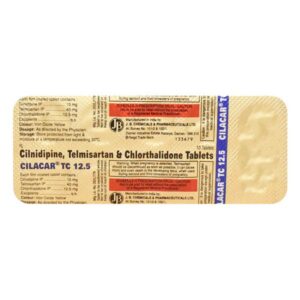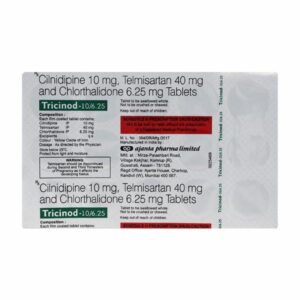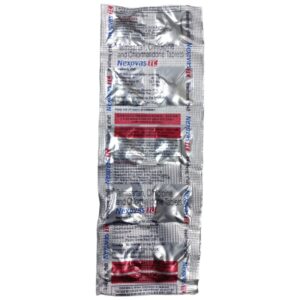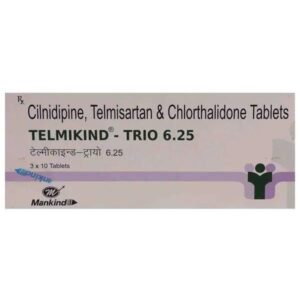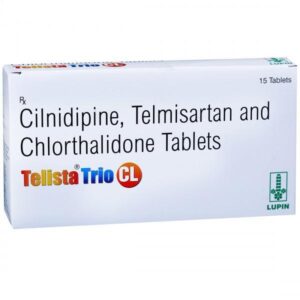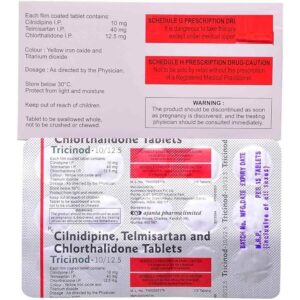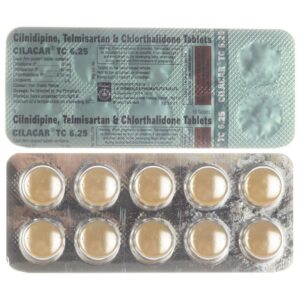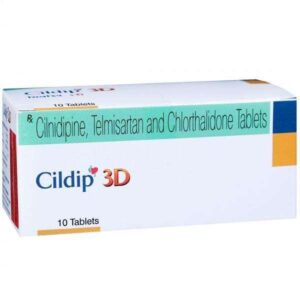CHLORTHALIDONE + TELMISARTAN + CILNIDIPINE
Chlorthalidone: Chlorthalidone is a diuretic medication used to treat high blood pressure, edema (fluid retention), and other conditions related to excessive fluid buildup in the body. It belongs to the class of medications known as thiazide diuretics.
The mechanism of action of chlorthalidone involves increasing the excretion of sodium and water from the kidneys, leading to decreased fluid volume in the body. This, in turn, helps to lower blood pressure. Chlorthalidone primarily acts on the distal convoluted tubule of the kidney, inhibiting the reabsorption of sodium and chloride ions.
The usual starting dose of chlorthalidone for hypertension is 25 milligrams (mg) once daily, which can be increased if necessary to a maximum dose of 50 mg per day. For edema, the initial dose is typically 50 mg once daily, and may also be adjusted as needed. Dosage instructions can vary based on the individual’s condition and response to treatment, so it’s important to follow the healthcare professional’s guidance.
Common side effects of chlorthalidone may include increased urination, dizziness, lightheadedness, low blood pressure, electrolyte imbalances (such as low levels of potassium or sodium), muscle cramps, nausea, and skin rash. Rare but potentially serious side effects can also occur, including severe allergic reactions, pancreatitis, electrolyte abnormalities, and blood disorders. It is essential to promptly report any unusual or severe side effects to a healthcare provider.
Chlorthalidone should not be used by individuals with an allergy to sulfonamides, as it contains a sulfonamide group. It may also interact with other medications, so it’s crucial to inform the healthcare provider about any other drugs or supplements being taken.
This is a general overview of chlorthalidone. It is always important to consult a healthcare professional or pharmacist for personalized advice and comprehensive information regarding the medication.
Telmisartan: Telmisartan is a medication belonging to the class of drugs called angiotensin II receptor blockers (ARBs). It is commonly prescribed to treat high blood pressure, also known as hypertension. Additionally, it can be used to reduce the risk of cardiovascular events such as heart attack or stroke in patients with certain risk factors.
The mechanism of action of telmisartan involves blocking the binding of angiotensin II to its receptors in blood vessels, leading to their relaxation and widening. This helps to lower blood pressure and improve blood flow. By inhibiting the effects of angiotensin II, telmisartan also reduces the release of aldosterone, a hormone that promotes water and salt retention, further contributing to its antihypertensive effects.
The usual initial dose of telmisartan for hypertension is 40 mg taken once daily. Depending on the patient’s response, the dose may be increased to a maximum of 80 mg per day. Telmisartan can be taken with or without food.
Some of the common side effects of telmisartan include dizziness, headache, fatigue, diarrhea, and back pain. It may also cause an increase in blood potassium levels, leading to symptoms such as muscle weakness or irregular heartbeat. However, serious side effects are rare but can include allergic reactions, swelling of the face or throat, difficulty breathing, and liver problems.
It is important to note that telmisartan should not be used during pregnancy as it may harm the fetus. Patients with a history of angioedema or hypersensitivity to telmisartan should also avoid using this medication.
As with any medication, it is crucial to follow the prescribed dosage and consult with a healthcare professional for proper guidance and monitoring while taking telmisartan.
Cilnidipine: Cilnidipine is a calcium channel blocker used to treat hypertension or high blood pressure. It is primarily prescribed for the management of essential hypertension (high blood pressure with no identified cause). It may also be used in the treatment of other cardiovascular conditions such as angina (chest pain) or Raynaud’s phenomenon.
The mechanism of action of cilnidipine involves blocking the entry of calcium ions into smooth muscle cells in the blood vessels. By inhibiting the influx of calcium, cilnidipine promotes relaxation and dilation of the blood vessels, resulting in decreased peripheral resistance and blood pressure.
The recommended starting dose of cilnidipine is typically 5 mg once daily. Depending on individual response, the dose may be increased to 10 mg once daily after a few weeks. The maximum recommended dose is 20 mg per day. It is crucial to follow the dosage instructions provided by the healthcare professional and not exceed the prescribed amount.
Like any medication, cilnidipine may cause side effects. Common side effects include swelling of the ankles or feet, headache, dizziness, flushing, increased heart rate, and fatigue. These side effects are usually mild and transient. However, if they persist or become bothersome, it is important to inform a healthcare provider.
It is worth noting that cilnidipine may not be suitable for everyone. Individuals with liver problems, low blood pressure, or heart conditions should exercise caution when using cilnidipine. It is essential to consult with a healthcare professional before starting this medication to ensure it is safe and appropriate for the individual’s specific medical condition and to prevent any potential drug interactions.


